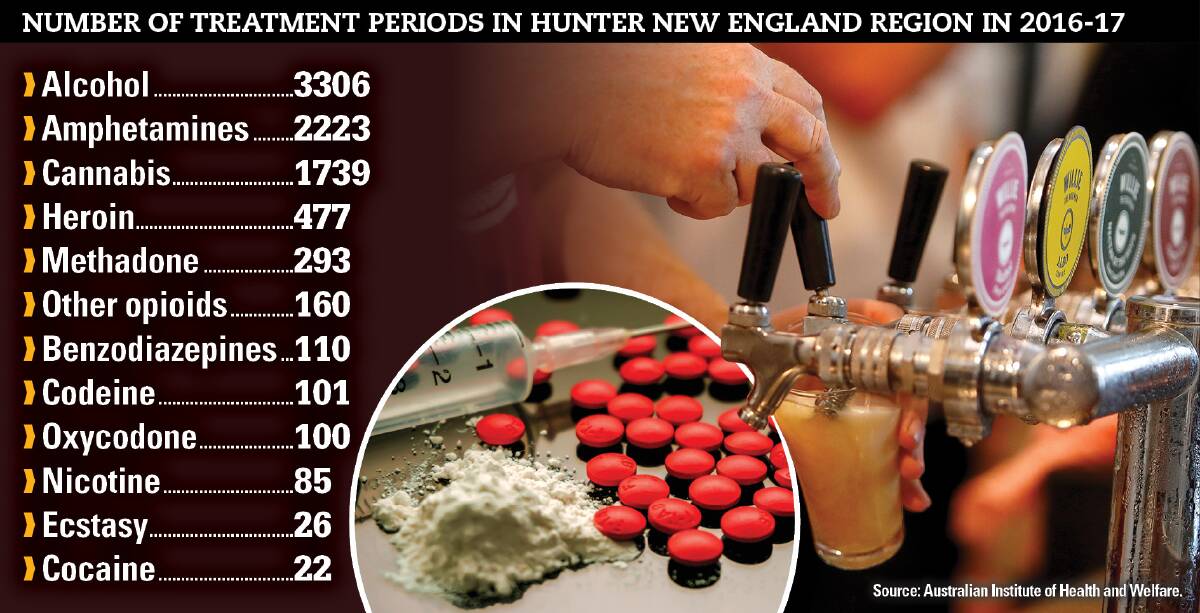
Alcohol remains the worst problem drug in the Hunter-New England Region by some distance, federal health data shows.
Subscribe now for unlimited access.
$0/
(min cost $0)
or signup to continue reading
The latest data shows 3306 “treatment periods” were sought for an alcohol problem in the region within a year.
The alcohol problem was followed by three illegal drugs. The data showed about 2223 “treatment periods” a year for amphetamines, 1739 for cannabis and 477 for heroin.
This so-called “treatment period” refers to contact between a client and publicly-funded health service at government and non-government agencies.
Hunter Primary Care drug and alcohol manager Kylie Bailey urged people to consider their drinking during the festive season.
“Now may be a time to reflect on how much you drink and consider making changes to how you drink,” Ms Bailey said.
State health data shows that a third of Hunter-New England residents aged 16 and over drink more than four standard drinks on a single occasion within a given month.
This level of drinking was considered to put people at “immediate risk of alcohol-related injury”.
The data also shows that about 37 per cent of Hunter-New England residents aged 16 and over drink more than two standard drinks on a day when they consume alcohol.
This level of drinking was considered to pose a long-term health risk.
Jo Mitchell, NSW Health’s executive director for the Centre for Population Health, said many alcoholic drinks were “more than one standard drink, so your blood alcohol content may rise more quickly than you think”.
“Check the label on the drink container for standard-drink information or pour your own drinks, so you know how much you’ve consumed,” Dr Mitchell said.
Ms Bailey said the National Health and Medical Research Council had concluded that “there were no safe levels of drinking alcohol”.
But she said the medical council had guidelines for “low-risk levels of drinking”.
Drinking more than two standard drinks a day (or almost daily) “increases your risk of developing alcohol-related disease”.
These included weight gain, gut problems, cardiovascular and liver disease and alcohol-related dementia, along with alcohol-linked injuries from incidents such as falls.
“If you drink regularly and consume more than two standard drinks every time you drink, you may want to consider reducing your drinking, having a break from alcohol, or possibly quitting drinking.”
She said those who drink less than eight standard drinks a day can “follow controlled drinking strategies to help reduce alcohol consumption”.
This included understanding the nature of a standard drink. Examples include one nip of spirits, 100 millilitres of wine or a middy of full-strength beer.
Control strategies also include setting a limit on the number of drinks on any occasion and switching from full-strength beer to low- or mid-strength beer.
Other strategies include alternating between non-alcoholic and alcoholic drinks, keeping count of drinks, avoiding gulping, putting drinks down between sips, diluting drinks and eating before drinking.
For those who decide to quit drinking, Ms Bailey said “you can either stop drinking or set a quit date and follow controlled drinking strategies to help reach your abstinence goal”.
“However, if you drink a minimum of eight to 10 standard drinks a day, you will be at risk of experiencing alcohol withdrawal symptoms if you quit cold turkey.
“The more alcohol you consume and the longer you’ve been drinking, the more severe the alcohol withdrawal symptoms.”
These symptoms last five to seven days and typically start six to 24 hours after stopping drinking.
Ms Bailey said the guidelines state that “drinking more than four standard drinks per drinking occasion (at a party or BBQ, for example) doubles your risk of alcohol-related harms”.
These include injuries, being a victim or perpetrator of an assault, engaging in risky behaviour, hangovers and alcohol overdose.
She said the guidelines also state that if you’re “pregnant, breastfeeding or planning to be pregnant or breastfeed, then no alcohol is the safest option”.
“One binge drinking episode when pregnant can cause fetal alcohol spectrum disorder in the baby.”

